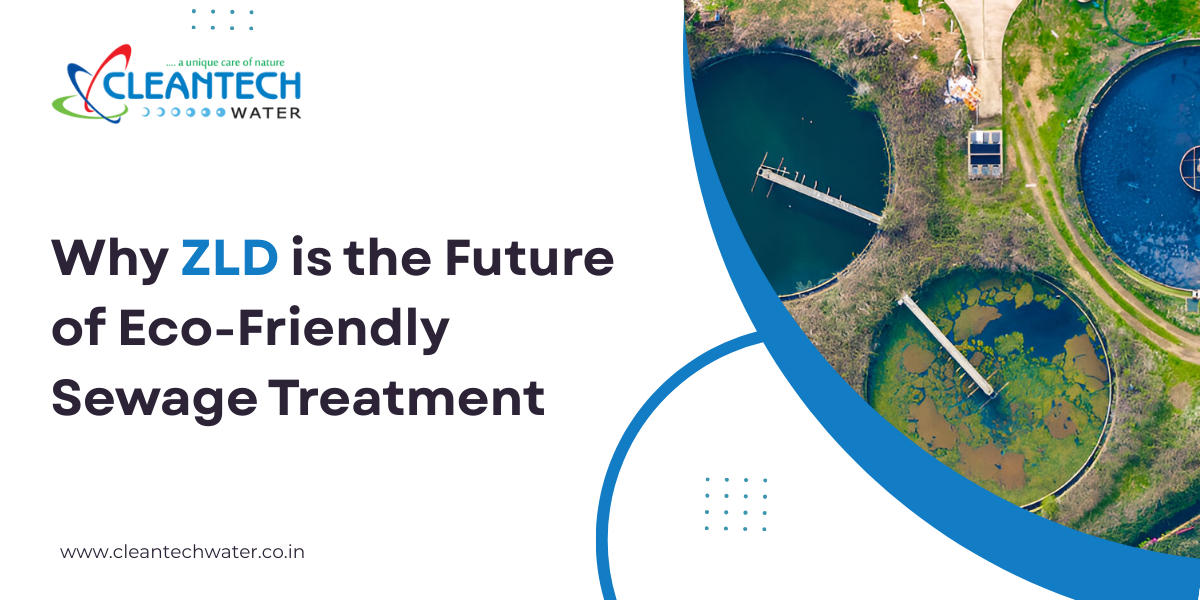In the face of growing environmental concerns, water scarcity, and stricter government regulations, the demand for sustainable wastewater solutions is reaching unprecedented levels. One of the most promising innovations in this space is Zero-Liquid Discharge (ZLD)—a comprehensive approach that ensures no liquid waste is released from the wastewater treatment plants. For industries and municipalities aiming to enhance water reuse, achieve regulatory compliance, and minimise their environmental footprint, ZLD is no longer just an option—it’s becoming a necessity.
As a leading wastewater treatment company, we are witnessing a paradigm shift in how water resources are managed. Businesses and communities are increasingly investing in technologies such as domestic water treatment plants and advanced sewage treatment plants that integrate ZLD principles.
In this article, we explore why ZLD is fast becoming the future of eco-friendly sewage treatment and what this means for your investment decisions.

What is Zero-Liquid Discharge (ZLD)?
Zero-Liquid Discharge (ZLD) is a wastewater treatment strategy designed to recover almost all the water from effluent streams, leaving behind only solid waste and ensuring no liquid discharge. Unlike conventional wastewater treatment plants that discharge treated water into the environment, ZLD systems are designed to recover, recycle, and reuse water, leaving behind zero liquid waste.
ZLD systems typically involve a combination of primary treatment, advanced filtration, evaporation, and crystallisation. These technologies work together to separate contaminants and recover clean water that can be reused in industrial processes, gardening, or other non-potable applications. The solid residues can be disposed of responsibly or, in some cases, processed for material recovery.
Reasons Behind the Growing Demand for ZLD Systems
Regulatory Pressures and Environmental Policies
The Central Pollution Control Board (CPCB) and State Pollution Control Boards (SPCBs) in India are tightening their grip on pollution control, with stringent norms for wastewater discharge from industries and residential developments. ZLD has become a preferred compliance route for high-pollution sectors such as textiles, chemicals, and pharmaceuticals. A modern wastewater treatment plant integrated with ZLD capabilities is increasingly being mandated in industrial clusters and eco-sensitive zones.
Increasing Industrial and Municipal Water Stress
India is among the world’s most water-stressed countries, with growing urbanisation and industrialisation further intensifying the crisis. Municipalities and industrial estates are under pressure to reduce dependence on freshwater sources and optimise water reuse. A domestic or an industrial-scale wastewater treatment plant with ZLD ensures maximum water recovery, supporting sustainable development and resource conservation.
Corporate Sustainability Goals Driving Adoption
Forward-thinking businesses are aligning their operations with global sustainability standards like ESG (Environmental, Social, Governance) benchmarks. By implementing ZLD-based sewage treatment plants, companies not only meet compliance requirements but also enhance their brand image, attract eco-conscious investors, and demonstrate leadership in environmental stewardship.
Environmental Benefits of ZLD
Total Elimination of Liquid Waste
The core promise of Zero-Liquid Discharge (ZLD) is its ability to eliminate all forms of liquid waste. Traditional wastewater treatment plans often discharge treated effluents into nearby water bodies, which, despite meeting basic standards, may still contain trace pollutants. ZLD systems go a step further by recovering every drop of water and converting residual contaminants into solid waste. This ensures that no liquid effluent escapes into the environment, making it a highly eco-friendly solution, especially in ecologically sensitive regions.
Recovery and Reuse of Water and Valuable By-Products
ZLD transforms wastewater from a liability into a valuable asset. By deploying advanced technologies such as membrane filtration, evaporators, and crystallisers, ZLD systems recover clean water that can be reused within the facility or for non-potable purposes like landscaping or cooling. Additionally, salts, chemicals, and other by-products recovered during the process can be reused or sold, creating new revenue streams for industries. For businesses, this ability to extract value from waste is a major advantage.
Prevention of Groundwater and Surface Water Pollution
Improperly treated wastewater is a leading cause of contamination in rivers, lakes, and groundwater reservoirs. ZLD systems prevent such pollution by ensuring that no untreated or partially treated effluent enters the environment. This safeguards aquatic ecosystems, protects drinking water sources, and reduces the burden on over-stressed water bodies—an increasingly critical concern in many parts of India.
Book a Free System Assessment Now!
ZLD and Circular Economy in Wastewater Management
Turning Waste into Resources
One of the foundational principles of the circular economy is minimising waste by reintroducing resources into the production cycle. ZLD embodies this principle by treating wastewater not as waste, but as a resource. By recovering water, minerals, and other valuable compounds, ZLD-equipped wastewater treatment plants contribute to a closed-loop system, reducing the need for virgin materials and cutting down operational costs.
Enhancing Water Reuse and Reducing Dependence on Freshwater Sources
India’s water crisis demands innovative solutions that reduce reliance on freshwater for industrial and domestic use. By integrating ZLD with a sewage treatment plant, communities and industries can significantly reduce their freshwater intake. This shift towards water reuse alleviates pressure on municipal supplies and enhances water security in drought-prone and water-scarce regions.
Supporting Long-Term Environmental and Economic Sustainability
ZLD systems offer dual benefits—environmental protection and long-term cost savings. Although initial investments may be higher, the ability to reuse water and by-products reduces operational costs over time. Moreover, industries that adopt ZLD demonstrate strong environmental responsibility, gaining favor with regulators, investors, and consumers.
Industries Leading the ZLD Adoption
Textiles and Dyeing
The textile industry, notorious for high volumes of chemically contaminated wastewater, is among the earliest adopters of ZLD in India. ZLD-enabled wastewater treatment plants help textile units meet pollution norms and conserve water through effective recycling.
Power Plants
Thermal power stations use vast amounts of water for cooling and operations. By integrating ZLD with their sewage treatment plants, they minimise environmental discharge and improve water efficiency.
Oil & Gas and Petrochemical Sectors
These sectors deal with complex effluents containing hydrocarbons and heavy metals. ZLD technologies allow them to meet strict environmental standards while recovering valuable resources.
Food and Beverage Processing
With high water usage and strict hygiene requirements, the food and beverage industry benefits greatly from ZLD systems that reduce wastewater output and ensure water reuse in cleaning and processing operations.
Technological Innovations Making ZLD More Efficient
Membrane Filtration, Evaporators, and Crystallisers
The backbone of any Zero-Liquid Discharge (ZLD) system lies in its robust combination of technologies. Modern wastewater treatment plants now employ a range of advanced tools like membrane filtration, mechanical evaporators, and crystallisers. Membrane systems such as reverse osmosis (RO) remove dissolved solids and contaminants at the micro-level, enabling high-quality water recovery. Evaporators then concentrate the remaining brine, while crystallisers extract solid waste—ensuring no liquid discharge remains. These technologies are now more compact, efficient, and scalable than ever, making them suitable for small and large scale plants.
Integration of AI and Automation for Smarter Water Management
The integration of AI, IoT, and automation is transforming how ZLD systems are operated and maintained. Smart sensors and real-time monitoring tools help optimise water flow, detect inefficiencies, and predict maintenance requirements, significantly reducing downtime and operational costs. AI-driven control systems can adjust treatment parameters based on inflow quality and usage patterns, enhancing the overall efficiency of the wastewater treatment plant. These innovations allow facilities to operate with greater precision and resource efficiency, paving the way for sustainable water reuse.
Energy-Efficient Advancements in ZLD Systems
One of the primary concerns around ZLD has traditionally been its energy consumption. However, recent developments in heat integration, hybrid systems, and energy recovery technologies are addressing this challenge. Multi-effect evaporators and thermocompressors help reduce energy usage during the evaporation phase. These improvements make ZLD systems more environmentally friendly and more financially viable over the long term.
Challenges and Considerations
High Initial Investment and Operational Costs
While the long-term benefits of ZLD are substantial, the initial capital investment remains a key concern for many businesses. ZLD systems require high-spec equipment, precision engineering, and skilled operation. This can make the upfront cost higher than that of conventional plants, particularly for small-scale facilities or municipal setups.
Energy Consumption and Maintenance Complexities
Despite technological advancements, ZLD processes still consume significant energy. Regular maintenance and system calibration are also essential to ensure smooth performance. These factors contribute to higher operational costs and require a dedicated management strategy.
Site-Specific Design and Engineering Requirements
No two wastewater treatment plants are exactly alike. ZLD systems must be tailored to the specific nature of the waste, the industry type, and the geographical location. Factors like wastewater volume, contamination levels, and local climate can influence the design. As a result, engineering precision and customisation are critical for successful ZLD implementation.
Why ZLD is the Future of Eco-Friendly Sewage Treatment
Alignment with Global Environmental and ESG Goals
As India and the world move toward more responsible environmental practices, ZLD aligns seamlessly with global sustainability and ESG (Environmental, Social, and Governance) frameworks. It supports cleaner production, resource conservation, and pollution reduction—making it an ideal choice for companies aiming to meet international green benchmarks.
Long-Term Cost Efficiency Through Water Recovery
Although the initial cost of setting up a ZLD-enabled plant may be high, the long-term cost savings through water recovery, reduced raw water usage, and compliance benefits can outweigh these expenses. Many industries are already reaping these returns by integrating ZLD into their infrastructure.
Readiness for Future Environmental Regulations
With water scarcity and pollution control taking center stage in future policy discussions, ZLD positions businesses ahead of regulatory curves. Investing in ZLD now ensures compliance with future wastewater discharge standards while supporting broader environmental stewardship goals.
Take the Lead in Sustainable Water Management with a Smart Wastewater Treatment Plant
Future-proof your operations and contribute to a cleaner environment by investing in state-of-the-art wastewater treatment plants. Whether you’re managing an industrial facility or overseeing a residential community, at Cleantech Water, our advanced solutions offer reliable compliance, superior water recovery, and long-term savings.
Partner with India’s leading wastewater treatment experts and discover how our tailor-made systems can transform your sewage treatment strategy into an eco-friendly, future-ready solution. Contact us at +91-9099915539 /+91-9558996411 or write to us at info@cleantechwater.co.in for a consultation and take the first step towards responsible water management. Let’s build a greener tomorrow, together.

